The Catalytic Activity of Carbon-Supported Cu(I)-Phosphine Complexes for the Microwave-Assisted Synthesis of 1,2,3-Triazoles
Abstract
:1. Introduction
2. Results and Discussion
2.1. Characterization of the Carbon Materials
2.2. Heterogenization Efficiency
2.3. Microwave-Assisted One-Pot Synthesis of 1,2,3-Triazoles
3. Materials and Methods
3.1. General Procedures
3.2. Treatments of the Carbon Materials
3.3. Heterogenization Protocol
3.4. Catalytic Essays
4. Conclusions
Supplementary Materials
Author Contributions
Funding
Acknowledgments
Conflicts of Interest
References
- Dheer, D.; Singh, V.; Shankar, R. Medicinal attributes of 1,2,3-triazoles: Current developments. Bioorg. Chem. 2017, 71, 30–54. [Google Scholar] [CrossRef] [PubMed]
- Victoria Gil, M.; José Arévalo, M.; López, Ó. Click chemistry-what’s in a name? Triazole synthesis and beyond. Synthesis (Stuttg). 2007, 1589–1620. [Google Scholar] [CrossRef]
- Tornøe, C.W.; Christensen, C.; Meldal, M. Peptidotriazoles on Solid Phase: [1,2,3]-Triazoles by Regiospecific Copper(I)-Catalyzed 1,3-Dipolar Cycloadditions of Terminal Alkynes to Azides. J. Org. Chem. 2002, 67, 3057–3064. [Google Scholar] [CrossRef] [PubMed]
- Rostovtsev, V.V.; Green, L.G.; Fokin, V.V.; Sharpless, K.B. A Stepwise Huisgen Cycloaddition Process: Copper(I)-Catalyzed Regioselective “Ligation” of Azides and Terminal Alkynes. Angew. Chemie 2002, 114, 2708–2711. [Google Scholar] [CrossRef]
- Díez-González, S. Well-defined copper(i) complexes for Click azide–alkyne cycloaddition reactions: One Click beyond. Catal. Sci. Technol. 2011, 1, 166–178. [Google Scholar] [CrossRef] [Green Version]
- Hein, J.E.; Fokin, V.V. Copper-catalyzed azide–alkyne cycloaddition (CuAAC) and beyond: New reactivity of copper(i) acetylides. Chem. Soc. Rev. 2010, 39, 1302–1315. [Google Scholar] [CrossRef]
- Dervaux, B.; Du Prez, F.E. Heterogeneous azide-alkyne click chemistry: Towards metal-free end products. Chem. Sci. 2012, 3, 959–966. [Google Scholar] [CrossRef]
- Chassaing, S.; Bénéteau, V.; Pale, P. When CuAAC “Click Chemistry” goes heterogeneous. Catal. Sci. Technol. 2016, 6, 923–957. [Google Scholar] [CrossRef]
- De Almeida, M.P.; Martins, L.M.D.R.S.; Carabineiro, S.A.C.; Lauterbach, T.; Rominger, F.; Hashmi, A.S.K.; Pombeiro, A.J.L.; Figueiredo, J.L. Homogeneous and heterogenised new gold C-scorpionate complexes as catalysts for cyclohexane oxidation. Catal. Sci. Technol. 2013, 3, 3056–3069. [Google Scholar] [CrossRef] [Green Version]
- Martins, L.M.D.R.S.; De Almeida, M.P.; Carabineiro, S.A.C.; Figueiredo, J.L.; Pombeiro, A.J.L. Heterogenisation of a C-scorpionate FeII complex on carbon materials for cyclohexane oxidation with hydrogen peroxide. ChemCatChem 2013, 5, 3847–3856. [Google Scholar] [CrossRef]
- Sutradhar, M.; Martins, L.M.D.R.S.; Carabineiro, S.A.C.; Guedes da Silva, M.F.C.; Buijnsters, J.G.; Figueiredo, J.L.; Pombeiro, A.J.L. Oxidovanadium(V) Complexes Anchored on Carbon Materials as Catalysts for the Oxidation of 1-Phenylethanol. ChemCatChem 2016, 8, 2254–2266. [Google Scholar] [CrossRef]
- Martins, L.M.D.R.S.; Ribeiro, A.P.C.; Carabineiro, S.A.C.; Figueiredo, J.L.; Pombeiro, A.J.L. Highly efficient and reusable CNT supported iron(ii) catalyst for microwave assisted alcohol oxidation. Dalton Trans. 2016, 45, 6816–6819. [Google Scholar] [CrossRef] [PubMed] [Green Version]
- Wang, J.; Martins, L.M.D.R.S.; Ribeiro, A.P.C.; Carabineiro, S.A.C.; Figueiredo, J.L.; Pombeiro, A.J.L. Supported C-Scorpionate Vanadium(IV) Complexes as Reusable Catalysts for Xylene Oxidation. Chem. An Asian J. 2017, 12, 1915–1919. [Google Scholar] [CrossRef] [PubMed]
- Carabineiro, S.A.C.; Martins, L.M.D.R.S.; Pombeiro, A.J.L.; Figueiredo, J.L. Commercial Gold(I) and Gold(III) Compounds Supported on Carbon Materials as Greener Catalysts for the Oxidation of Alkanes and Alcohols. ChemCatChem 2018, 10, 1804–1813. [Google Scholar] [CrossRef]
- Nasrollahzadeh, M.; Mohammad Sajadi, S.; Rostami-Vartooni, A.; Khalaj, M. Green synthesis of Pd/Fe3O4 nanoparticles using Euphorbia condylocarpa M. bieb root extract and their catalytic applications as magnetically recoverable and stable recyclable catalysts for the phosphine-free Sonogashira and Suzuki coupling reactions. J. Mol. Catal. A Chem. 2015, 396, 31–39. [Google Scholar] [CrossRef]
- Fakhri, P.; Jaleh, B.; Nasrollahzadeh, M. Synthesis and characterization of copper nanoparticles supported on reduced graphene oxide as a highly active and recyclable catalyst for the synthesis of formamides and primary amines. J. Mol. Catal. A Chem. 2014, 383–384, 17–22. [Google Scholar] [CrossRef]
- Figueiredo, J.L. Functionalization of porous carbons for catalytic applications. J. Mater. Chem. A 2013, 1, 9351–9364. [Google Scholar] [CrossRef]
- Figueiredo, J.L.; Pereira, M.F.R. Synthesis and functionalization of carbon xerogels to be used as supports for fuel cell catalysts. J. Energy Chem. 2013, 22, 195–201. [Google Scholar] [CrossRef]
- Alonso, F.; Moglie, Y.; Radivoy, G.; Yus, M. Multicomponent synthesis of 1,2,3-triazoles in water catalyzed by copper nanoparticles on activated carbon. Adv. Synth. Catal. 2010, 352, 3208–3214. [Google Scholar] [CrossRef] [Green Version]
- Sharghi, H.; Beyzavi, M.H.; Safavi, A.; Doroodmand, M.M.; Khalifeh, R. Immobilization of porphyrinatocopper nanoparticles onto activated multi-walled carbon nanotubes and a study of its catalytic activity as an efficient heterogeneous catalyst for a click approach to the three-component synthesis of 1,2,3-triazoles in water. Adv. Synth. Catal. 2009, 351, 2391–2410. [Google Scholar] [CrossRef]
- Silva, A.R.; Figueiredo, J.L.; Freire, C.; De Castro, B. Copper(II) acetylacetonate anchored onto an activated carbon as a heterogeneous catalyst for the aziridination of styrene. Catalysis Today 2005, 102–103, 154–159. [Google Scholar] [CrossRef]
- Silva, A.R.; Freitas, M.M.A.; Freire, C.; De Castro, B.; Figueiredo, J.L. Heterogenization of a functionalized copper(II) Schiff base complex by direct immobilization onto an oxidized activated carbon. Langmuir 2002, 18, 8017–8024. [Google Scholar] [CrossRef]
- Silva, A.R.; Martins, M.; Freitas, M.M.A.; Figueiredo, J.L.; Freire, C.; de Castro, B. Anchoring of Copper(II) Acetylacetonate onto an Activated Carbon Functionalised with a Triamine. Eur. J. Inorg. Chem. 2004, 2004, 2027–2035. [Google Scholar] [CrossRef]
- Mahmoud, A.G.; Guedes da Silva, M.F.C.; Pombeiro, A.J.L. 3,7-Diacetyl-1,3,7-triaza-5-phosphabicyclo[3.3.1]nonane (DAPTA) and derivatives: Coordination chemistry and applications. Coord. Chem. Rev. 2020, 213614. [Google Scholar] [CrossRef]
- Mahmoud, A.G.; Guedes da Silva, M.F.C.; Sokolnicki, J.; Smoleński, P.; Pombeiro, A.J.L. Hydrosoluble Cu(I)-DAPTA complexes: Synthesis, characterization, luminescence thermochromism and catalytic activity for microwave-assisted three-component azide-alkyne cycloaddition click reaction. Dalton Trans. 2018, 47, 7290–7299. [Google Scholar] [CrossRef]
- Kappe, C.O. Microwave dielectric heating in synthetic organic chemistry. Chem. Soc. Rev. 2008, 37, 1127–1139. [Google Scholar] [CrossRef]
- Appukkuttan, P.; Dehaen, W.; Fokin, V.V.; Van der Eycken, E. A Microwave-Assisted Click Chemistry Synthesis of 1,4-Disubstituted 1,2,3-Triazoles via a Copper(I)-Catalyzed Three-Component Reaction. Org. Lett. 2004, 6, 4223–4225. [Google Scholar] [CrossRef]
- Özçubukçu, S.; Ozkal, E.; Jimeno, C.; Pericàs, M.A. A highly active catalyst for huisgen 1, 3-dipolar cycloadditions based on the tris(triazolyl)methanol-Cu(I) structure. Org. Lett. 2009, 11, 4680–4683. [Google Scholar] [CrossRef]
- Cintas, P.; Martina, K.; Robaldo, B.; Garella, D.; Boffa, L.; Cravotto, G. Improved Protocols for Microwave-Assisted Cu(I)-Catalyzed Huisgen 1,3-Dipolar Cycloadditions. Collect. Czechoslov. Chem. Commun. 2007, 72, 1014–1024. [Google Scholar] [CrossRef]
- Mahmoud, A.G.; Martins, L.M.D.R.S.; Guedes da Silva, M.F.C.; Pombeiro, A.J.L. Copper complexes bearing C-scorpionate ligands: Synthesis, characterization and catalytic activity for azide-alkyne cycloaddition in aqueous medium. Inorganica Chim. Acta 2018, 483, 371–378. [Google Scholar] [CrossRef]
- Mahmoud, A.G.; Guedes da Silva, M.F.C.; Mahmudov, K.T.; Pombeiro, A.J.L. Arylhydrazone ligands as Cu-protectors and -catalysis promoters in the azide–alkyne cycloaddition reaction. Dalton Trans. 2019, 48, 1774–1785. [Google Scholar] [CrossRef] [PubMed]
- Mahmoud, A.G.; Smolénski, P.; Guedes Da Silva, M.F.C.; Pombeiro, A.J.L. molecules Water-Soluble O-, S-and Se-Functionalized Cyclic Acetyl-triaza-phosphines. Synthesis, Characterization and Application in Catalytic Azide-alkyne Cycloaddition. Molecules 2020, 25, 5479. [Google Scholar] [CrossRef] [PubMed]
- Fuerte, A.; Iglesias, M.; Sánchez, F. New chiral diphosphinites: Synthesis of Rh complexes. Heterogenisation on zeolites. J. Organomet. Chem. 1999, 588, 186–194. [Google Scholar] [CrossRef]
- Benvenuti, F.; Carlini, C.; Raspolli Galletti, A.M.; Sbrana, G.; Marchionna, M.; Patrini, R. 1,3-Butadiene telomerization with methanol catalyzed by heterogenized palladium complexes. J. Mol. Catal. A Chem. 1999, 137, 49–63. [Google Scholar] [CrossRef]
- Gerber, I.; Oubenali, M.; Bacsa, R.; Durand, J.; Gonçalves, A.; Pereira, M.F.R.; Jolibois, F.; Perrin, L.; Poteau, R.; Serp, P. Theoretical and Experimental Studies on the Carbon-Nanotube Surface Oxidation by Nitric Acid: Interplay between Functionalization and Vacancy Enlargement. Chem. A Eur. J. 2011, 17, 11467–11477. [Google Scholar] [CrossRef]
- Figueiredo, J.L.; Pereira, M.F.R.; Freitas, M.M.A.; Órfão, J.J.M. Modification of the surface chemistry of activated carbons. Carbon N. Y. 1999, 37, 1379–1389. [Google Scholar] [CrossRef]
- Mahata, N.; Pereira, M.F.R.; Suárez-García, F.; Martínez-Alonso, A.; Tascón, J.M.D.; Figueiredo, J.L. Tuning of texture and surface chemistry of carbon xerogels. J. Colloid Interface Sci. 2008, 324, 150–155. [Google Scholar] [CrossRef]
- Serp, P.; Corrias, M.; Kalck, P. Carbon nanotubes and nanofibers in catalysis. Appl. Catal. A Gen. 2003, 253, 337–358. [Google Scholar] [CrossRef]
- Martínez, M.T.; Callejas, M.A.; Benito, A.M.; Cochet, M.; Seeger, T.; Ansón, A.; Schreiber, J.; Gordon, C.; Marhic, C.; Chauvet, O.; et al. Sensitivity of single wall carbon nanotubes to oxidative processing: Structural modification, intercalation and functionalisation. Carbon N. Y. 2003, 41, 2247–2256. [Google Scholar] [CrossRef]
- Romanos, G.E.; Likodimos, V.; Marques, R.R.N.; Steriotis, T.A.; Papageorgiou, S.K.; Faria, J.L.; Figueiredo, J.L.; Silva, A.M.T.; Falaras, P. Controlling and quantifying oxygen functionalities on hydrothermally and thermally treated single-wall carbon nanotubes. J. Phys. Chem. C 2011, 115, 8534–8546. [Google Scholar] [CrossRef]
- Barros, E.B.; Filho, A.G.S.; Lemos, V.; Filho, J.M.; Fagan, S.B.; Herbst, M.H.; Rosolen, J.M.; Luengo, C.A.; Huber, J.G. Charge transfer effects in acid treated single-wall carbon nanotubes. Carbon N. Y. 2005, 43, 2495–2500. [Google Scholar] [CrossRef]
- Sharghi, H.; Khalifeh, R.; Doroodmand, M.M. Copper nanoparticles on charcoal for multicomponent catalytic synthesis of 1,2,3-triazole derivatives from benzyl halides or alkyl halides, terminal alkynes and sodium azide in water as a “green” solvent. Adv. Synth. Catal. 2009, 351, 207–218. [Google Scholar] [CrossRef]
- Samim, M.; Kaushik, N.K.; Maitra, A. Effect of size of copper nanoparticles on its catalytic behaviour in Ullman reaction. Bull. Mater. Sci. 2007, 30, 535–540. [Google Scholar] [CrossRef]
- Shaffer, M.S.P.; Fan, X.; Windle, A.H. Dispersion and packing of carbon nanotubes. Carbon N. Y. 1998, 36, 1603–1612. [Google Scholar] [CrossRef]
- Díez-González, S.; Escudero-Adán, E.C.; Benet-Buchholz, J.; Stevens, E.D.; Slawin, A.M.Z.; Nolan, S.P. [(NHC)CuX] complexes: Synthesis, characterization and catalytic activities in reduction reactions and Click Chemistry. On the advantage of using well-defined catalytic systems. Dalton Trans. 2010, 39, 7595–7606. [Google Scholar] [CrossRef]
- Bock, V.D.; Hiemstra, H.; Van Maarseveen, J.H. Cu I-catalyzed alkyne-azide “click” cycloadditions from a mechanistic and synthetic perspective. European J. Org. Chem. 2006, 51–68. [Google Scholar] [CrossRef]
- Choong, E.S. Immobilisation of chiral catalysts: Easy recycling of catalyst and improvement of catalytic efficiencies. Annu. Reports Prog. Chem. Sect. C 2005, 101, 143–173. [Google Scholar] [CrossRef]
- Shaygan Nia, A.; Rana, S.; Döhler, D.; Jirsa, F.; Meister, A.; Guadagno, L.; Koslowski, E.; Bron, M.; Binder, W.H. Carbon-Supported Copper Nanomaterials: Recyclable Catalysts for Huisgen [3+2] Cycloaddition Reactions. Chem. A Eur. J. 2015, 21, 10763–10770. [Google Scholar] [CrossRef]
- Nasrollahzadeh, M.; Jaleh, B.; Fakhri, P.; Zahraei, A.; Ghadery, E. Synthesis and catalytic activity of carbon supported copper nanoparticles for the synthesis of aryl nitriles and 1,2,3-triazoles. RSC Adv. 2015, 5, 2785–2793. [Google Scholar] [CrossRef]
- Hosseinzadeh, R.; Sepehrian, H.; Shahrokhi, F. Preparation of Cu(OAc)2/MCM-41 catalyst and its application in the one-pot synthesis of 1,2,3-triazoles in water. Heteroat. Chem. 2012, 23, 415–421. [Google Scholar] [CrossRef]
- Himo, F.; Lovell, T.; Hilgraf, R.; Rostovtsev, V.V.; Noodleman, L.; Sharpless, K.B.; Fokin, V.V. Copper(I)-catalyzed synthesis of azoles. DFT study predicts unprecedented reactivity and intermediates. J. Am. Chem. Soc. 2005, 127, 210–216. [Google Scholar] [CrossRef] [PubMed]
- Rodionov, V.O.; Fokin, V.V.; Finn, M.G. Mechanism of the Ligand-Free CuI-Catalyzed Azide-Alkyne Cycloaddition Reaction. Angew. Chemie 2005, 117, 2250–2255. [Google Scholar] [CrossRef]
- Rodionov, V.O.; Presolski, S.I.; Díaz, D.D.; Fokin, V.V.; Finn, M.G. Ligand-accelerated Cu-catalyzed azide-alkyne cycloaddition: A mechanistic report. J. Am. Chem. Soc. 2007, 129, 12705–12712. [Google Scholar] [CrossRef] [PubMed]
- Straub, B.F. μ-Acetylide and μ-alkenylidene ligands in “click” triazole syntheses. Chem. Commun. 2007, 3868–3870. [Google Scholar] [CrossRef] [PubMed]
- Özen, C.; Tüzün, N.Ş. The mechanism of copper-catalyzed azide-alkyne cycloaddition reaction: A quantum mechanical investigation. J. Mol. Graph. Model. 2012, 34, 101–107. [Google Scholar] [CrossRef]
- Baxter, C.W.; Higgs, T.C.; Bailey, P.J.; Parsons, S.; McLachlan, F.; McPartlin, M.; Tasker, P.A. Copper(I) alkynyl clusters, [Cux+y(hfac)x(C≡CR) y], with Cu10-Cu12 cores. Chem. A Eur. J. 2006, 12, 6166–6174. [Google Scholar] [CrossRef]
- Ben El Ayouchia, H.; Bahsis, L.; Anane, H.; Domingo, L.R.; Stiriba, S.E. Understanding the mechanism and regioselectivity of the copper(i) catalyzed [3 + 2] cycloaddition reaction between azide and alkyne: A systematic DFT study. RSC Adv. 2018, 8, 7670–7678. [Google Scholar] [CrossRef] [Green Version]
- Berg, R.; Straub, B.F. Advancements in the mechanistic understanding of the copper-catalyzed azide-alkyne cycloaddition. Beilstein J. Org. Chem. 2013, 9, 2715–2750. [Google Scholar] [CrossRef] [Green Version]
- Ribeiro, A.P.C.; Martins, L.M.D.R.S.; Carabineiro, S.A.C.; Figueiredo, J.L.; Pombeiro, A.J.L. Gold Nanoparticles Deposited on Surface Modified Carbon Xerogels as Reusable Catalysts for Cyclohexane C-H Activation in the Presence of CO and Water. Molecules 2017, 22, 603. [Google Scholar] [CrossRef] [Green Version]
- Ribeiro, A.P.C.; Martins, L.M.D.R.S.; Carabineiro, S.A.C.; Figueiredo, J.L.; Pombeiro, A.J.L. Gold nanoparticles deposited on surface modified carbon materials as reusable catalysts for hydrocarboxylation of cyclohexane. Appl. Catal. A Gen. 2017, 547, 124–131. [Google Scholar] [CrossRef]
- Maia, F.; Mahata, N.; Jarrais, B.; Silva, A.R.; Pereira, M.F.R.; Freire, C.; Figueiredo, J.L. Jacobsen catalyst anchored onto modified carbon xerogel as enantioselective heterogeneous catalyst for alkene epoxidation. J. Mol. Catal. A Chem. 2009, 305, 135–141. [Google Scholar] [CrossRef]

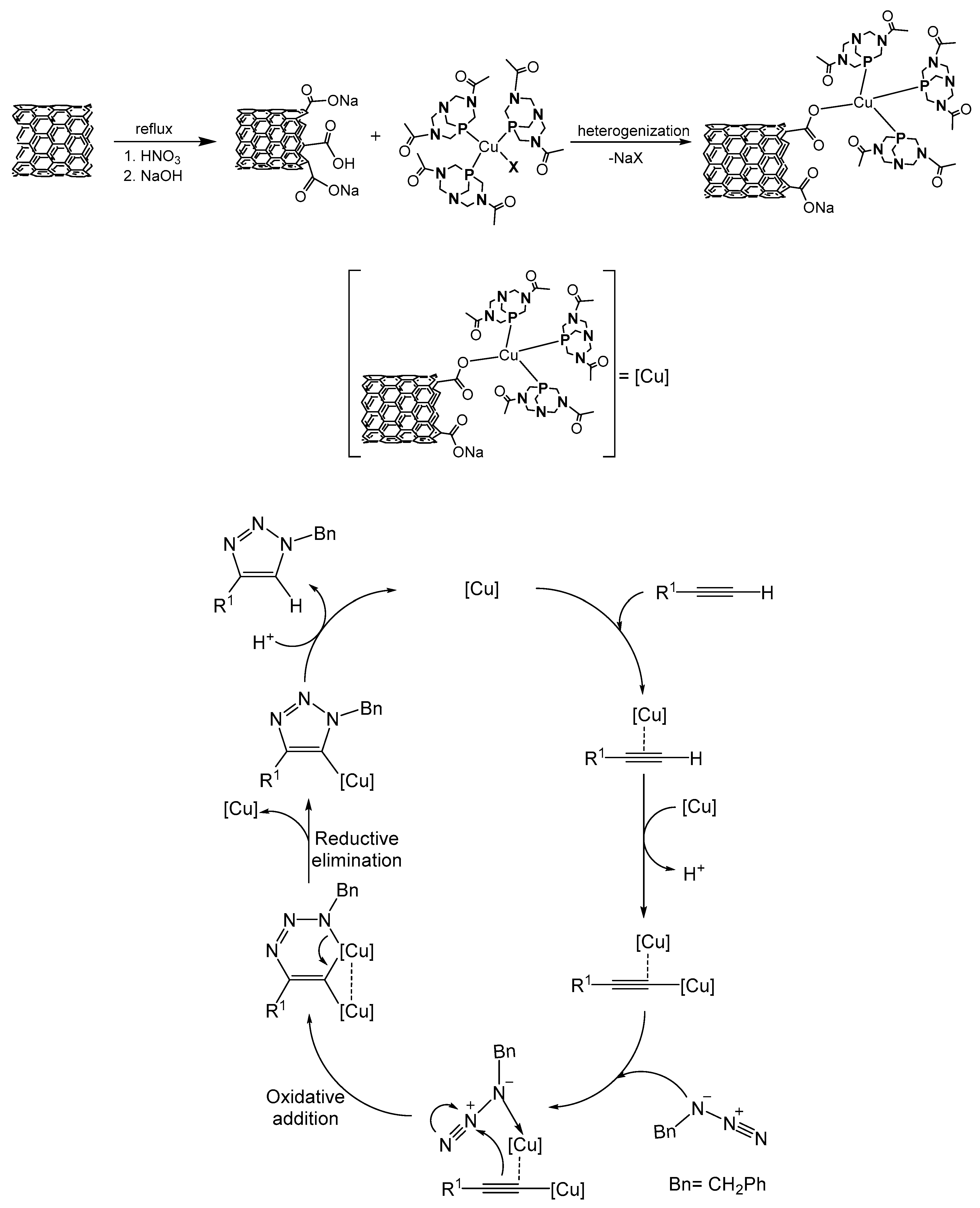
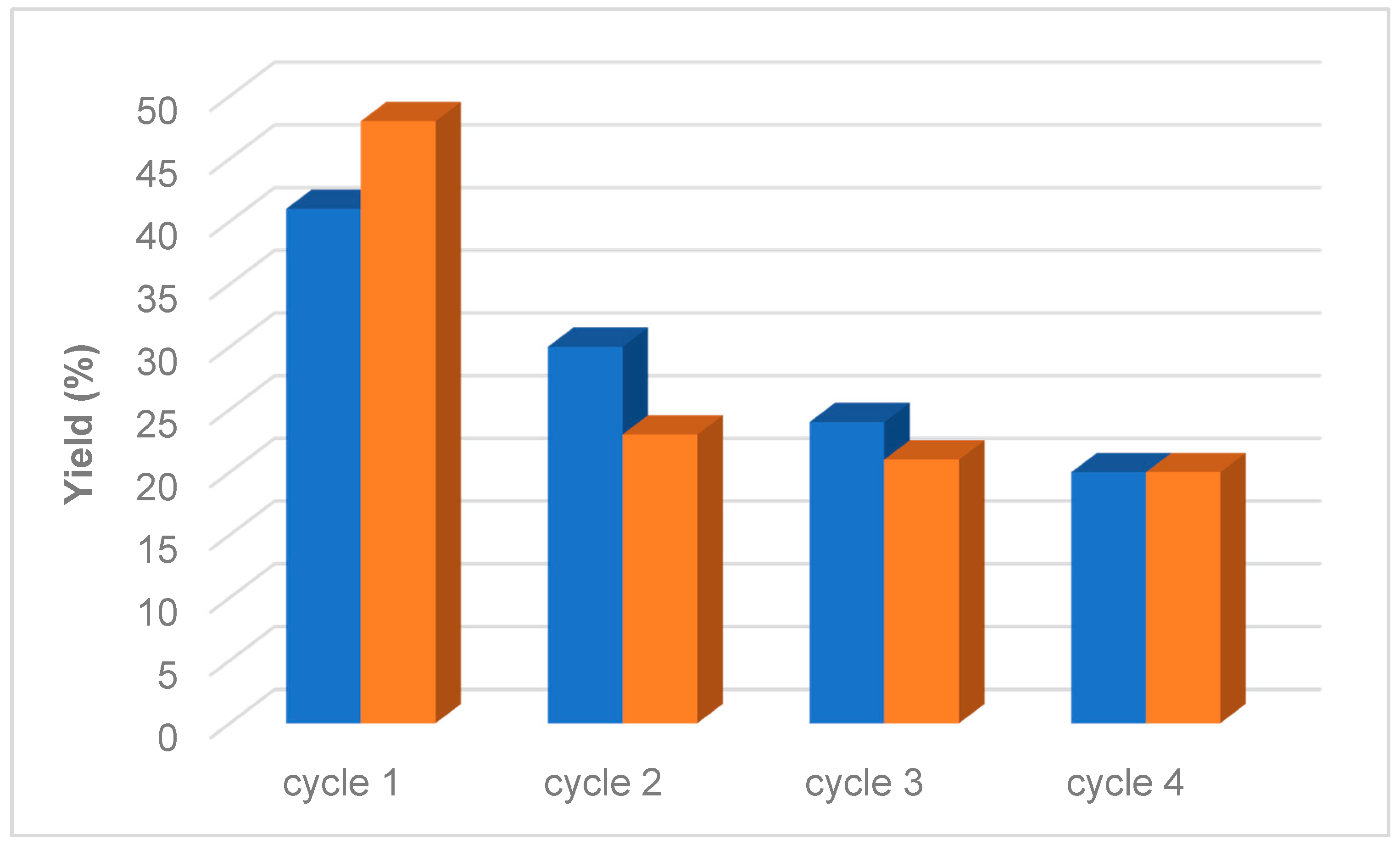
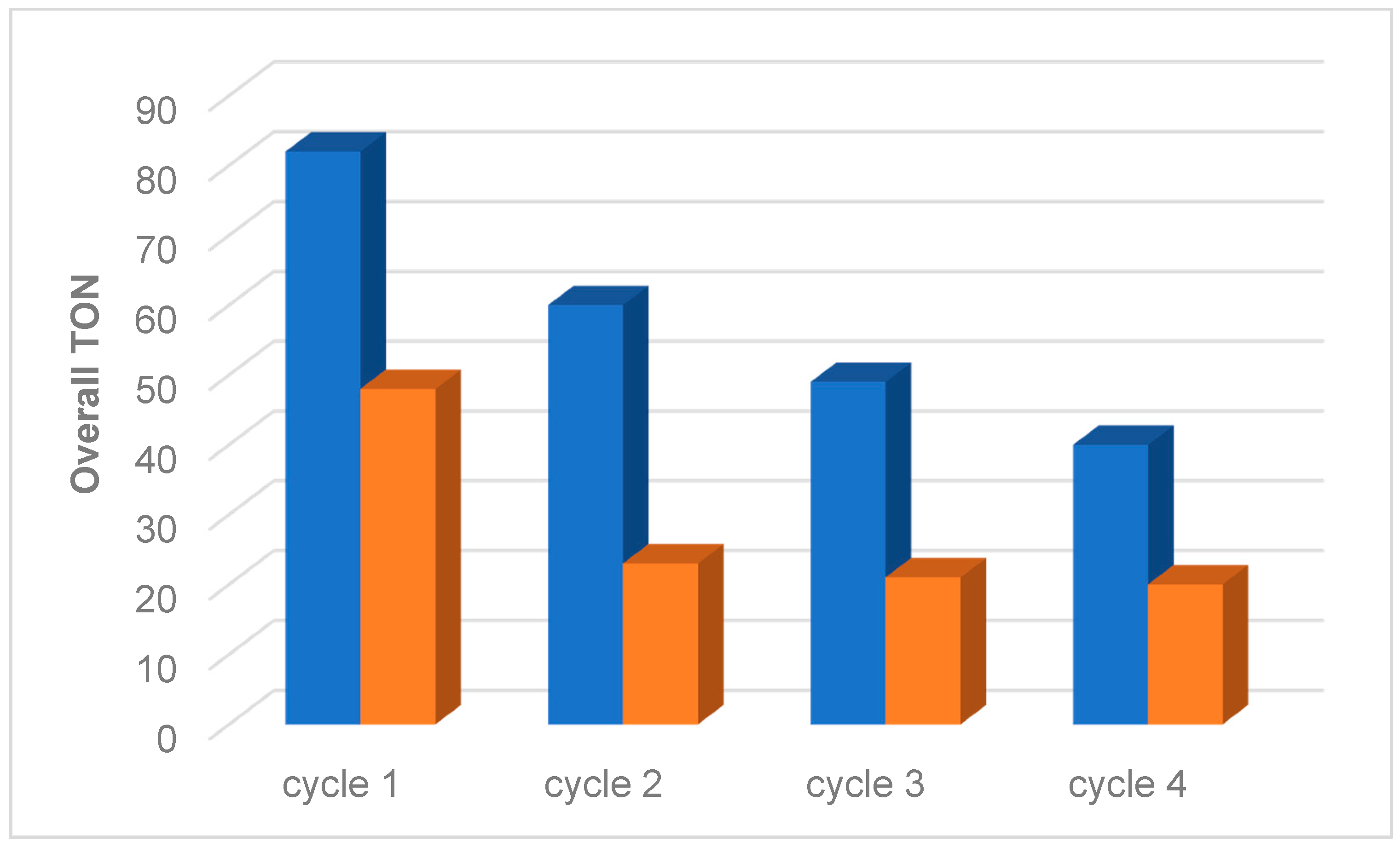
| Carbon Material | SBET, m2 g−1 | Pore Volume, cm3 g−1 | Pore Size, nm |
|---|---|---|---|
| AC | 866 | 0.45 | 5.2 |
| AC-ox | 223 | 0.22 | 5.0 |
| AC-ox-Na | 191 | 0.15 | 4.9 |
| CNT | 256 | 2.54 | 30.9 |
| CNT-ox | 288 | 1.37 | 17.4 |
| CNT-ox-Na | 253 | 1.16 | 16.3 |
| Carbon Material | Cu Complex | |||||||
|---|---|---|---|---|---|---|---|---|
| 1 | 2 | 3 | 4 | |||||
| g/L | % | g/L | % | g/L | % | g/L | % | |
| AC | 0.01 | 0.1 | 0.02 | 0.3 | 0 | 0 | 0.01 | 0.1 |
| AC-ox | 0.07 | 0.9 | 0.06 | 0.8 | 0.05 | 0.6 | 0.04 | 0.5 |
| AC-ox-Na | 0.11 | 1.5 | 0.11 | 1.5 | 0.09 | 1.2 | 0.12 | 1.6 |
| CNT | 0 | 0 | 0.01 | 0.1 | 0 | 0 | 0 | 0 |
| CNT-ox | 0.06 | 0.8 | 0.02 | 0.3 | 0.03 | 0.4 | 0 | 0 |
| CNT-ox-Na | 0.06 | 0.8 | 0.11 | 1.5 | 0.06 | 0.8 | 0.10 | 1.3 |

| Entry | Complex | Support | Catalyst Loading b, mol% | Time, min | Total Volume of Solvent, mL | Yield c, % | TON d |
|---|---|---|---|---|---|---|---|
| 1 | 1 | AC-ox-Na | 0.5 | 15 | 1.5 | 30.5 | 61 |
| 2 | 2 | AC-ox-Na | 0.5 | 15 | 1.5 | 31.4 | 63 |
| 3 | 3 | AC-ox-Na | 0.5 | 15 | 1.5 | 22 | 44 |
| 4 | 4 | AC-ox-Na | 0.5 | 15 | 1.5 | 20 | 39 |
| 5 | 1 | CNT-ox-Na | 0.5 | 15 | 1.5 | 23 | 46 |
| 6 | 2 | CNT-ox-Na | 0.5 | 15 | 1.5 | 41 | 82 |
| 7 | 3 | CNT-ox-Na | 0.5 | 15 | 1.5 | 29 | 59 |
| 8 | 4 | CNT-ox-Na | 0.5 | 15 | 1.5 | 33 | 66 |
| 9 | 1 | AC-ox-Na | 0.5 | 15 | 1.5 | 27 e | 54 |
| 10 | 2 | AC-ox-Na | 0.5 | 15 | 1.5 | 32 e | 65 |
| 11 | 2 | CNT-ox-Na | 0.5 | 15 | 1.5 | 40 e | 80 |
| 12 | 3 | AC-ox-Na | 0.5 | 15 | 1.5 | 29 e | 59 |
| 13 | 4 | AC-ox-Na | 0.5 | 15 | 1.5 | 38 e | 75 |
| 14 | 4 | CNT-ox-Na | 0.5 | 15 | 1.5 | 40 e | 80 |
| 15 | 2 | CNT-ox-Na | 0.5 | 30 | 1.5 | 29 | 59 |
| 16 | 2 | CNT-ox-Na | 0.1 | 15 | 1.5 | 21 | 207 |
| 17 | 2 | CNT-ox-Na | 0.5 | 15 | 2.0 | 32 | 65 |
| 18 | 2 | CNT-ox-Na | 0.5 | 30 | 2.0 | 27 | 55 |
| 19 | 2 | CNT-ox-Na | 0.5 | 15 | 1.0 | 17 | 34 |
| 20 | 2 | CNT-ox-Na | 0.5 | 30 | 1.0 | 23 | 46 |
| 21 | 4 | CNT-ox-Na | 0.1 | 30 | 1.5 | 23 | 230 |
| 22 | 4 | CNT-ox-Na | 0.5 | 30 | 1.5 | 25 | 50 |
| 23 | 4 | CNT-ox-Na | 0.5 | 60 | 1.5 | 42 | 84 |
| 24 | 4 | CNT-ox-Na | 1.0 | 15 | 1.5 | 48 | 48 |
| Entry | Catalyst | Benzyl Bromide | Product | Time, min | Yield b, % | TON |
|---|---|---|---|---|---|---|
| 1 | 2_CNT-ox-Na |  |  | 15 | 38 | 76 |
| 2 | 2_CNT-ox-Na |  | 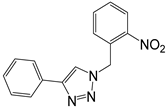 | 15 | 48 | 97 |
| 3 | 2_CNT-ox-Na |  |  | 15 | 49 | 98 |
| 4 | 4_CNT-ox-Na |  | 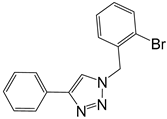 | 60 | 51 | 101 |
| 5 | 4_CNT-ox-Na |  |  | 60 | 37 | 74 |
| 6 | 4_CNT-ox-Na |  |  | 60 | 39 | 79 |
| 7 | 4_CNT-ox-Na |  |  | 60 | 37 | 74 |
| 8 | 4_CNT-ox-Na |  |  | 60 | 32 | 64 |
Publisher’s Note: MDPI stays neutral with regard to jurisdictional claims in published maps and institutional affiliations. |
© 2021 by the authors. Licensee MDPI, Basel, Switzerland. This article is an open access article distributed under the terms and conditions of the Creative Commons Attribution (CC BY) license (http://creativecommons.org/licenses/by/4.0/).
Share and Cite
Librando, I.L.; Mahmoud, A.G.; Carabineiro, S.A.C.; Guedes da Silva, M.F.C.; Geraldes, C.F.G.C.; Pombeiro, A.J.L. The Catalytic Activity of Carbon-Supported Cu(I)-Phosphine Complexes for the Microwave-Assisted Synthesis of 1,2,3-Triazoles. Catalysts 2021, 11, 185. https://doi.org/10.3390/catal11020185
Librando IL, Mahmoud AG, Carabineiro SAC, Guedes da Silva MFC, Geraldes CFGC, Pombeiro AJL. The Catalytic Activity of Carbon-Supported Cu(I)-Phosphine Complexes for the Microwave-Assisted Synthesis of 1,2,3-Triazoles. Catalysts. 2021; 11(2):185. https://doi.org/10.3390/catal11020185
Chicago/Turabian StyleLibrando, Ivy L., Abdallah G. Mahmoud, Sónia A. C. Carabineiro, M. Fátima C. Guedes da Silva, Carlos F. G. C. Geraldes, and Armando J. L. Pombeiro. 2021. "The Catalytic Activity of Carbon-Supported Cu(I)-Phosphine Complexes for the Microwave-Assisted Synthesis of 1,2,3-Triazoles" Catalysts 11, no. 2: 185. https://doi.org/10.3390/catal11020185









